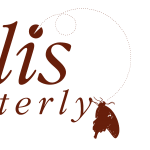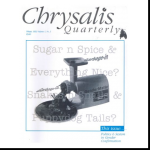Since 1990, Chrysalis Quarterly has been a driving force in the formation of transgender community and the fight for transgender rights. Now we’re available in electronic format—and we need your essays, articles, interviews, photographs, poems, and short fiction!
©2013 by Dallas Denny
Editor
 Dallas Denny is the founder and editor-in-chief of Chrysalis Quarterly.
Dallas Denny is the founder and editor-in-chief of Chrysalis Quarterly.
She’s a writer, educator, and mental health professional who divides her time time between tiny Pine Lake, GA and the Hudson Valley.
She’d love to hear from you.
More About Dallas Send an E-Mail to DallasThe Name
 Chrysalis is the name for the pupal stage of the order of insects that includes butterflies. A caterpillar goes in; a butterfly comes out. A transformation takes place.
Chrysalis is the name for the pupal stage of the order of insects that includes butterflies. A caterpillar goes in; a butterfly comes out. A transformation takes place.
It’s an apt metaphor for transsexualism, which is also characterized by a transition.
That’s where the name came from, and why Chrysalis’ masthead shows a butterfly newly emerged from its pupal case, drying its wings in preparation for flying away in a new and beautiful body.
The masthead was designed by Margaux Ayn Schaefer.
History
 In September 1990 I produced and distributed a one-page flyer telling the world about a new magazine. It was to be called Chrysalis Quarterly, and it would soon become legendary.
In September 1990 I produced and distributed a one-page flyer telling the world about a new magazine. It was to be called Chrysalis Quarterly, and it would soon become legendary.
Chrysalis’ publisher was a forming nonprofit: The Atlanta Educational Gender Information Service. The target audience was in equal parts transsexuals, nontranssexual transgendered people, loved ones, and helping professionals. The initial flyer for AEGIS went out in the same mailing that heralded the arrival of Chrysalis Quarterly.
I had never edited or published a magazine before, only newsletters. My computer, a Commodore 64, had only a rudimentary windowing program, and I had no idea how to design, lay out, print, or distribute a magazine. I didn’t let that stop me.
Two talented designers came forward to help. Stephanie Rose laid out the first two issues using Quark XPress. Margaux Ayn Schaefer designed the cover of issue #2 and produced a corporate identity package for AEGIS— by then The American Educational Gender Information Service— and, keying from Stephanie’s work, redesigned the magazine. Margaux’ design premiered in issue #3.
A friend who worked in a print shop printed the pages and covers of the first five issues free of charge, and a group of volunteers would gather at my home— which was also AEGIS headquarters— to fold pages and hand-assemble some 1300 issues.
With a newly-obtained bulk mail permit from the U.S. Postal Service, we mailed the first issue in late 1990 to the members of the newly-formed AEGIS and to support groups and nonprofits around the world.
Chrysalis Quarterly began as an 8 1/2″ x 11″ magazine printed in two colors, stapled, with a glossy stiff cover and between 48 and 64 pages of text. Each issue was themed, addressing subjects important to transsexuals and other transgendered people: health, transformative medical procedures, relationships with families and friends, work, and community. Two issues had guest editors: in 1995, Jason Cromwell put together an all-FTM issue (#7), and in 1998 intersex activists Cheryl Chase and Martha Coventry edited issue #12.
It soon became clear funds were insufficient to print the magazine on a quarterly basis. I changed the name to Chrysalis: The Journal of Transgressive Gender Identities and began volume 2. I of course modified AEGIS’ database to make sure members got four issues before we asked them to renew.
By 1995 it had become clear to me that the world of publishing— and for that matter, the world at large— was about to change. The days of stamp-and-envelope nonprofits were coming to an end; they were just too inefficient and expensive and wasteful of resources to compete with a new medium that would offer access of an unlimited amount of information to an infinite number of people for practically no cost.
The new medium was, of course, the internet, then in its infancy.
I stopped taking subscriptions and made preparations to wind down the magazine— and AEGIS itself.
The last issue of Chrysalis was #12, which was published in early 1998. On January 1, 2000, AEGIS relaunched as Gender Education & Advocacy, Inc.
Now Chrysalis is back in electronic format.
Significance
As AEGIS’ flagship publication, Chrysalis Quarterly reflected the organization’s statement of purpose, which was: We promote nonjudgemental and nondiscriminatory treatment of persons with gender dysphoria, and advocate respect for their dignity, their right to treatment, and their right to choose their gender. As strange as it may sound now, in 1990, years before the term transgender was used to describe our community, those were radical words.
By the late 1990s so much social progress had been made that the mission statement was no longer controversial. Since AEGIS had effectively met its corporate goal, I initiated a rollover to the present-day Gender Education & Advocacy, Inc., which maintains AEGIS’ 501(c)(3) nonprofit status.
GEAIn its twelve-issue run between 1990 and 1998, Chrysalis was a driving force in transgender sensibility, thought, and theory. It featured articles by Anne Bolin, Suzanne Kessler, Jamison Green, Holly Boswell, Toby Meltzer, Gianna Israel, Kim Stuart, Stephen Whittle, Phaedra Kelly, Christine Beatty, Rachel Pollack, Merissa Sherrill Lynn, Callan Williams, Riki Anne Wilchins, Peggy Rudd, Bill Henkin, Jessica Xavier, Michael Hernandez, Sheila Kirk, Richard Ekins, Linda Phillips, Ruth Hubbard, and many others— including myself. Many of the idea advanced by the authors significantly influenced discourse, and some were revolutionary— for instance Holly Boswell’s “The Transgender Alternative,” which appeared in issue #2, reintroduced the term transgender as an umbrella for all gender-variant people. Chrysalis‘ content has been widely cited in books and research papers and back issues are collector’s items.
With its attractive layout, great writers, rational tone, and important subject material, Chrysalis made critical contributions to the fledgling understanding of transgendered and transsexual people and did much to advance the above-stated goals of AEGIS. I’m proud to have been the magazine’s founder and editor.
Chrysalis Today
Chrysalis Quarterly has re-launched as an electronic journal.
Like the original magazine, the new Chrysalis is witty, intelligent, provocative, and occasionally irreverent. Like the original, we do not shy away from controversial topics. Unlike the original, we’re no longer a quarterly, for we no longer have to prepare material and send it to the printer. We retain the name Chrysalis Quarterly because we like it.
We post material as we receive and edit them. That means new articles, fiction, editorials, photo essays, reviews, and poetry will be constantly appearing on the home page.
We offer a variety of inexpensive and innovate advertising opportunities for advertisers.


